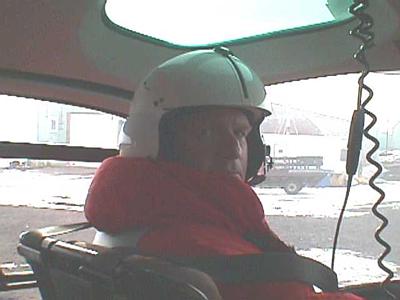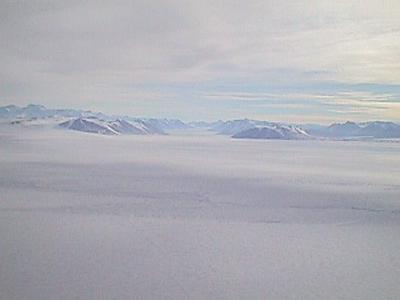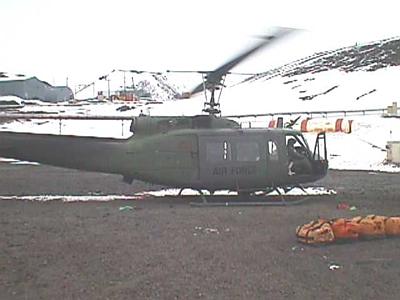14 November, 1999
As you probably have figured out by now, I made it to Cape Roberts. What an
experience! I now feel I really have been to Antarctica. In fact, until I
visited Cape Roberts, I had not actually set foot on the continent. McMurdo
is located on Ross Island off the coast of Antarctica. But now I have walked
on the frozen continent. It was very moving and humbling thought to think
that I had this chance that so few people will.
I don't know where to start telling you about the trip. I
experienced so many things in a short period of time (26 hours); the edge of
the sea and the open water of the Ross Sea, massive valley and piedmont
glaciers, icebergs, seals with new born pups, the Cape Roberts Base camp,
the drilling site on the sea ice and an exploration of ice caves. It will
take me several days to tell you all of it. However, I have to start with
the experience I have been looking forward to for a very long time. My first
helicopter ride.
Ever since I was a little kid watching a show called "Whirlybirds"
on TV at my grandmothers' place, I have wanted to fly in a "chopper".
Helicopters or "helos" are the workhorses for the transportation of
materials and people around Ross Island. Each day that the weather allows,
helos are flying in and out constantly. The helos flown by the NSF are
primarily operated by a company out of Lafayette, Louisiana called PHI.
Another helo is flown by the New Zealand Air Force in support of the
Antarctic research program.
When I first arrived at the helo pad with the 3 other people scheduled to go
with me, the first thing they did was weigh us and all our equipment. Each
helo has a very strict weight limit for cargo and passengers. I won't tell
you how much I weighed. I will only say that the food is very good here and
the ECW gear weighs an awful lot. After weighing, it was determined that all
4 passengers could not go We were too heavy for the Astar helo we were
taking. John Wrenn, the scientist I am working with, graciously agreed to
wait for a later flight. I think he could see the excitement in my eyes and
he had been out there before. Because of John not going, there was room for
60 pounds of frozen chicken to fly out to the drill site, so I am sure the
people at Cape Roberts were happy.
After weigh-in, we donned our helmets, grabbed our bags and headed
for the helo. But not before getting an "all clear" signal from the pilot.
Safety is critical around the spinning blades of a helo. I was required to
go to a helo safety briefing before I was even allowed on the pad. John, the
PHI pilot, gave us the thumbs up signal and we approached the aircraft. I
got to sit in the front left seat. Massimo Pompilio and Wojciech Majewski
sat in the back. John helped me buckle in, plug in my radio and we were
ready to go. The aircraft began to vibrate as the blades picked up speed.
Before I realized it, we were hovering above the surface. Slowly we lifted
above the ground. Just like "Whirlybirds"! We gained altitude and soon we
were high above Mactown.
We headed out over the sea ice towards Cape Roberts. We were
traveling at a speed of about 100 miles per hour. I got my first panoramic
view of the Transantarctic Mountains, the Ross Sea, Ross Island and the
Scott Coast of Antarctica. On the flight, which lasted about 50 minutes,
John pointed out many of the features along the coast including glacial
moraines and crevasses, high mountain peaks, the Dry Valleys of McMurdo and
the various features on the sea ice. The visibility was over 100 miles! John
said today was a bit hazy, you could usually see even further.
The flight was amazing smooth. Too soon we arrived at Camp Roberts
Base Camp with our load of frozen chicken.
The return helo flight was a much different experience. We flew on a
helo flown by Squadron 3 of the Royal New Zealand Air Force. The aircraft
was called an Iroquois and is like the type flown by the U.S. Army during
the Vietnam War. The Kiwi aircrew was very efficient and business-like.
Cargo was loaded, we were strapped in and we were off on the return flight.
The older Iroquois aircraft provided a rougher flight than the Astar we flew
out on. We had to make a fuel stop at a place called Marble Point. This is a
fuel depot located about half way between McMurdo and Cape Roberts. This is
also used as an emergency landing spot in case of bad weather or mechanical
problems.
When we got to Ross Island, we made a quick stop at the Kiwi
station, Scott Base and then back to the helo pad at Mactown. The travel was
over but I will remember my first helo experience forever. I hope it isn't
my last.
Tomorrow I will tell you all about the Base Camp at Cape Roberts. It
is a unique little community huddled on the sea ice. In the coming days I
will tell you about the rest of my experience. Stay tuned!

Here I am, ready for my first helo flight!

The Astar on the ice at Cape Roberts.

The glaciers and mountains of the Scott Coast from the seat of a helo.

Wojciech (right) and I ready for the return flight.

The Iroquois of the Royal New Zealand Air Force on the helo pad at McMurdo.
Contact the TEA in the field at
.
If you cannot connect through your browser, copy the
TEA's e-mail address in the "To:" line of
your favorite e-mail package.
|
